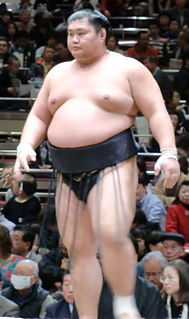
Miyabiyama Tetsushi is a former sumo wrestler from Mito, Ibaraki, Japan. A former amateur champion, he turned professional in 1998. With the exception of two tournaments, he was ranked in the top division of professional sumo from 1999 until the end of his career in 2013, holding the second highest rank of ōzeki from 2000 to 2001. He won eight special prizes and was runner-up in four top division tournaments. He wrestled for Fujishima stable, where he worked as a coach until opening his own Futagoyama stable.

Tamanoshima Arata is a former sumo wrestler from Izumizaki, Fukushima, Japan. A former amateur champion, he made his professional debut in 1998, reaching the top makuuchi division at the end of 2000. He was twice runner-up in a tournament, and earned six special prizes and two gold stars during his career. His highest rank was sekiwake. He wrestled for Kataonami stable. He retired in November 2011 to become an elder of the Japan Sumo Association and is now known as Hanaregoma Oyakata. In December 2021 he became head coach of Hanaregoma stable.
Wakanoyama Hiroshi is a former sumo wrestler from Gobo, Wakayama Prefecture, Japan. His highest rank was komusubi.
Oginishiki Yasutoshi is a former sumo wrestler from Ichikawa, Chiba Prefecture, Japan. His highest rank was komusubi. His father and brother were also sumo wrestlers. He is now a coach at Dewanoumi stable.
The following are the events in professional sumo during 2005.
The following are the events in professional sumo during 2004.
The following are the events in professional sumo during 2002.
The following are the events in professional sumo during 2000.
The following are the events in professional sumo in 1998.
The following are the events in professional sumo during 1995.
The following are the events in professional sumo during 2010.

Wakakōyū Masaya is a former professional sumo wrestler from Funabashi, Japan. His highest rank was komusubi. The last two characters of his ring name were taken from his mentor and coach at Ōnomatsu, the former Masurao. He was only the second wrestler from his stable to reach the top division. He was runner-up in one tournament and earned one special prize, for Fighting Spirit. He is now a sumo coach.

Shikishima Katsumori is a former sumo wrestler from Funabashi, Chiba, Japan. He made his professional debut in January 1989, and reached the top division in November 1994. His highest rank was maegashira 1. He defeated Takanohana twice in 1998 to earn his only two kinboshi for a yokozuna upset. His stablemaster, former sekiwake Aonosato retired in November 2000 and he moved from Tatsutagawa stable to Michinoku stable. He retired in May 2001 after being diagnosed with a heart ailment, and has remained in sumo as an elder of the Japan Sumo Association and coach at Michinoku. He has borrowed a succession of elder names since his retirement. Since 2013 he has been known as Urakaze.
Zaōnishiki Toshimasa, birth name Toshimasa Adachi, was a sumo wrestler from Yamagata, Japan. He made his professional debut in September 1970, and reached the top division in November 1976. His highest rank was maegashira 1. He retired in January 1983 and served as an elder in the Japan Sumo Association under several successive names. He reached the retirement age for elders of 65 in September 2017, but stayed with the Sumo Association for an additional two years as a consultant.
Hōō Tomomichi, born Tomomichi Kabetani, was a sumo wrestler from Gamagōri, Aichi, Japan. He made his professional debut in September 1971, and reached the top division in July 1979. His highest rank was sekiwake. He is the only sekiwake since the six-tournaments-a-year schedule began in 1958 to never win a sanshō or special prize. He was one of the few wrestlers to face both Takanohana Kenshi and his son Takanohana Kōji, having fought the latter in the makushita division towards the end of his career. He left the sumo world upon retirement in May 1990. He died of heart disease in 2013.
Shinji Hamada, better known as Toyonoumi Shinji, was a Japanese sumo wrestler from Buzen, Fukuoka. He made his professional debut in March 1981 and reached the top division in November 1988. He was known by the shikona Takanohama until 1990. His highest rank was maegashira 1. He did not miss a single bout in his 19-year professional career. Upon retirement from active competition he became an elder in the Japan Sumo Association, under the name Yamahibiki. He left the Sumo Association in June 2002.

Tokushōryū Makoto is a Japanese professional sumo wrestler from Nara. He wrestles for Kise stable.
The following were the events in professional sumo during 2016.
The following are the events in professional sumo during 2018.
The following are the events in professional sumo during 2020.





